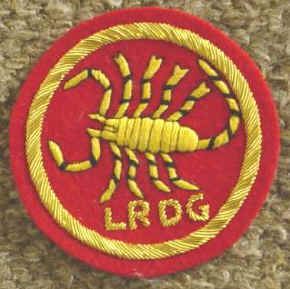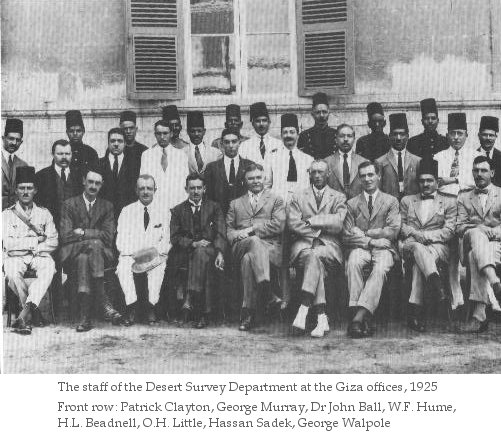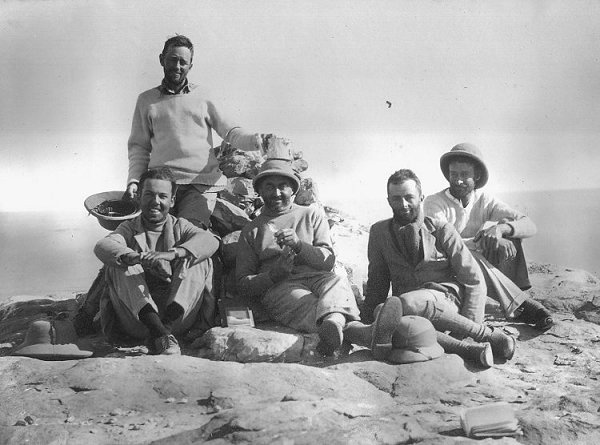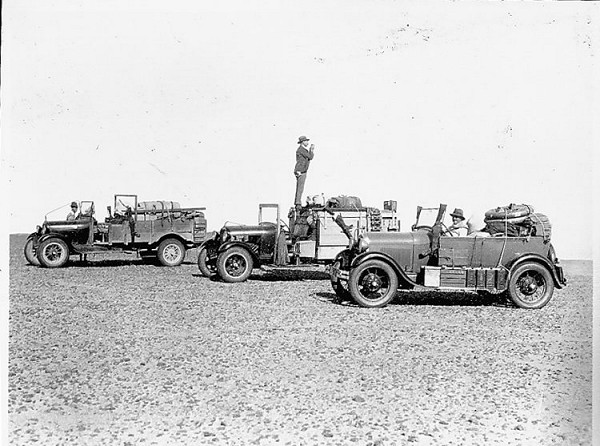FROM SIWA TO SINAI WITH
MAADI'S PRE-WW2 DESERT EXPLORERS
by Samir Raafat
Egyptian Gazette, Saturday November 29, 1996


|
|
|
|
|
|
EGY.COM - COMMUNITY
|
|
by Samir Raafat
Egyptian Gazette, Saturday November 29, 1996


In his address to the joint session of Parliament on November 10, President Mubarak in an unprecedented departure from the norm mentioned Viceroy Mohammed Ali and his grandson Khedive Ismail without the usual acrimony that accompanied their names during the past 44 years. The president also spoke of a rebirth of the Middle East through globalization. The speech was almost entirely devoted to the subject of economic achievements and economic reforms, both of which had been the sum and substance of the reigns of Mohammed Ali and Ismail. The first had modernized Egypt with worthwhile economic reforms during the first half of the 19th century and the second, deficient financial management aside, had initiated an impressive array of infrastructural projects.
The president also spoke of Egypt's New Frontier. This is a scheme to create a ''new delta'' by diverting water from the Upper Nile to connect oases in the western desert and increase the heavily overpopulated country's arable land by 25 percent. We've all noticed of late how our deserts are the focus of considerable media coverage and speculation. What many don't realize is that until very recently these were undiscovered regions. It is primarily thanks to a handful of early 20th century daredevil desert explorers that we were able to trace their geological makeup and chart their every dune and hollow.
It was in Maadi, during the latter part of WW2 that William Boyd Kennedy Shaw (1901-79) wrote his book "The Long Range Desert Group (1945)." In his preface he notes: "There are no two ways about deserts - either you dislike intensely being in them or you find their attractions hard to resist." Like several of his friends and neighbors, Shaw belonged to the second group.
Originally a botanist in the Sudan Forestry Department, it was during the War that Shaw joined his former Libyan Desert fellow-explorer, Brigadier Ralph Alger Bagnold (b.1896), in what was regarded a small but highly motivated military unit called the Long Range Desert Group (LRDG) hence the title of his book. The LRDG operated deep in the Libyan Desert (so-named by Herodotus) behind German and Italian lines with the objective of thwarting Rommel's efforts to enter Alexandria. The LRDG's feats and heroics are detailed in Shaw's book and mentioned in many subsequent publications, last of which was "Storm Command: A Personal Account Of The Gulf War" (1992) written by General Sir Peter de la Billiere's, Commander of the British Armed Forces during the 1991 Gulf War alias 'Desert Storm.'
Shaw was not the only one to have written books or papers on the subject of deserts while in residence in Cairo's suburb of Maadi. Maadi was the lifetime home to several other desert aficionados, namely the two successive directors of the Egyptian Survey Department (Mas-la-het al-Mi-ssa-ha), Dr. John Ball (1872-1941) scientist, engineer, astronomer and geologist and, George William Welsh Murray (1888-1966) described by a contemporary as the former's Elisha. These two gentlemen were leading members of the once prestigious Fouad Desert Institute headquartered in the beautiful Saracenic building in Heliopolis at an angle north of the Hindu-style Baron Empain palace. Later, when it fell on hard times, the Institute became the home of a regional Arab defense organization.
In the words of Major Claude Scudmore Jarvis (1879-1953), the British mudir (governor) of Sinai, Dr. John Ball was "a little man and looks the last person one would expect to be a hardy desert explorer". Hence, the disbelief that the placid Ball crisscrossed the Western in his tin lizzie (the Jeep's predecessor). Ball's specialty was navigating sand dunes, which, one can imagine, was an impossible feat in the days before the Mitsubishi Pajero, the Range Rover and the Toyota landcruiser.
When Ball wasn't challenging the desert he was busy charting it with the help of his ever ready compass and speedometer. Three times he accompanied desert explorers Prince Kamal al-Dine Hussein (son of Sultan Hussein Kamel) and Ahmed Hassanein Bey (later Pasha) the discoverer of Gabal Oweinat, on their famous expeditions into the Libyan Desert in search of the mythical Oasis of Zarzura, and, an alternate route to the Oasis of Kufra. These expeditions which often took up to three months each, covered the immense waste between Oweinat in the extreme south-west to Sollumn at the north and the Nile on the east.
While the first of these expeditions was carried out on Camel the latter ones were made possible thanks to specially French-built caterpillar vehicles.
In 1926, during his days as Director of the Egyptian Survey Department (which he joined in 1897), Dr. Ball dispatched his able assistant, George Frederick Walpole (1892-1975), to investigate a vague region in the Libyan Desert. Walpole who would later prepare and publish the 1/500,000 map of Egypt, discovered an extraordinary hollow 18,000 square kilometers - larger than Wales - with areas ranging from 50 to 134 meters below sea level. At one point, the hollow is separated from the Mediterranean Sea by an isthmus of 56 kilometers. Fascinated by this discovery, which he named the Qattara Depression after one of the principal salt springs at its northern margin, Ball wrote a series of papers and gave numerous lectures on how, by means of a tunnel linking the hollow to the sea, a hydraulic electric plant could be set up at the depression to provide ample electric power, roughly estimated at 160,000 horse power, to North Egypt.
In another one of his papers Dr. Ball put forward the theory that linking the Qattara Depression to the Mediterranean would bring great climatic benefits to Egypt across the Delta and Sinai. Regular rain falls pushed along by prevailing winds would promote it.


Many years later, in his book "Dare Me To The Desert" (1967) George Murray explains that Ball's design was "to admit the sea water at a rate of inflow exactly balanced at that of evaporation so that the inland lake thus formed would only be filled after long centuries by salt. Meanwhile, the continuous inrush of water through the tunnel (later referred to as John Ball's tunnel or canal) was to be harnessed by turbines to provide light and power to the whole Delta." Murray goes on to detail some of Ball's theories and some of the criticism laid out at the time.
George Murray became personally involved with the Qattara Depression, when, a year after Walpole's discovery, Ball sent him with another colleague from Maadi, Survey Inspector Patrick Andrew Clayton (1896-1962), back to the Libyan Desert to make a detailed survey around the contours of the depression itself. They were to run lines of levels across the isthmus between the Depression and the Mediterranean Sea. Unknown to both men then, these lines would be immortalized fourteen years later during WW2 when some of the fiercest tank battles took place pitting the Eighth Army against Erwin Rommel's fearless Panzerarmee. What was to have been John Ball's canal became one of the largest graveyards in the history of North Africa strewn with the bodies of thousands of young soldiers.
Under the joint supervision of Murray and Clayton the mapping and leveling around the Qattara Depression was completed within four years from 1927 to 1931. It was during this period, in 1928, that Clayton came across 23 dead and dying gazelles at the base of a low cliff in the Depression. These he supposed to have been stampeded during the night by a cheetah. With the progress of time and the help of a devastating desert war, wildlife of this magnitude would practically disappear from the area. Meanwhile, in 1931 another kind of depression, this time of an economic nature, would put an end to Ball's grand schemes for flooding the Great Hollow. After 43 years in the Survey of Egypt, Ball retired in 1932 and was succeeded by George Murray.
During his retirement, Dr. John Ball was the star speaker on numerous lecture tours and in various scientific societies. And to the delight of his Maadi friends and neighbors, he gave several talks at the Maadi Sporting Club for the benefit of the Diocesan Guild to which the proceeds of the 12 piaster tickets were destined. The enthralled audience was treated to Dr. Ball's recollections, animated with the help of photographs or lantern-slides, starting from when he was engaged in the construction of the Battersea bridge, London, to the sunnier days when he supervised the underpinnings of the Temples of Philae south of Aswan (1901-02) not forgetting his desert exploits aboard his faithful tin lizzie. Dr. John Ball is buried in the Protestant Cemetery in Old Cairo and his tombstone inscription appropriately reads "I will even make a way in the wilderness."
Just about when Dr. Ball passed away in his residence on Road 9, Maadi (survived by his wife Kate Russell Waite), his former assistant at the Egypt Survey Department was attempting a daring escape from a German prisoner-of-war camp west of Alamein. When WW2 broke out, Survey Inspector Patrick Clayton was deemed a valuable asset to the LRDG since he knew the Libyan desert like the palm of his hand. In fact, he had represented the Egyptian government during the 1927 demarcation of the Libyan-Egyptian border. His counterpart on the Libyan side, then divided into the Italian provinces of Tripolitania and Cyrenaica, was an officer by the name of Tenente Campo. During WW2 the border shifted positions back and forth several times before re-settling in its prewar location where 187 cairns had been put in place by the Campo-Clayton Boundary Commission and replaced with masonry pillars in 1938 under the technical supervision of George Murray.
At age 44, the Scottish highlander George Murray took over from Dr. Ball as Director of the Survey Department. Murray knew Egypt's deserts well having spent 25 years with the Department and having participated in several desert expeditions with his wife Edith Agnes and their two 64 pound Airedale dogs, "Rex the Enormous" and "Odd Without Asking". Moreover, in the 1930s, together with brigadier Ralph Bagnold, he undertook a study on driving through sand which would make solitary desert adventures of war possible in a few years time.
In total contrast to the diminutive John Ball, Murray was a very large man and should have been called "Murray The Enormous" rather than "Desert Murray" as he was known to all of his Maadi friends. In 1935 he wrote "Sons Of Ishmael", a study of the Egyptian Bedouins with particular emphasis on Sinai, and at about the same period, submitted several papers at the Cairo Scientific Society of which he was President until the outbreak of WW2. In 1946 he was nominated Vice President of the Institut d'Egypte. In "Dare Me To The Desert", Murray gives a vivid account of his trips into the Eastern Desert, and how, together with Edith and their dogs, they took off on the dirt tracks, always avoiding the asphalt, seeking new destinations along the Red Sea coast or the Sinai peninsula where he had been posted along with Clayton shortly after WW1.
When the Murrays were not touring the desert, they were entertaining the many desert lovers among their friends in their Maadi semidetached house at the corner of Roads 18 and 79 (now in the process of being pulled down). A frequent visitor who must have animated the conversation with her daring exploits at these gatherings was non other than the author-explorer extraordinaire, Miss Freya Madeline Stark.
George and Edith Murray had struck a friendship with Freya Stark sometime before the war. Beyond their shared enthusiasm for exploration and their common forays in the Western Desert, Murray joined Stark's "Brothers of Freedom Society" aimed at counter balancing, through the powers of persuasion as opposed to propaganda and deception, any pro-German sentiment that might be lurking around Egypt, Jordan and Palestine. The more skeptical among the Egyptians referred to the Society as a pro-British whispering campaign.
From the dozen or so followers who had originally met in Freya's Zamalek balcony and Murray's Maadi garden in 1941, the Brotherhood grew to 6,000 in 1943 by which time Freya Stark had already left Egypt in search of new challenges and other deserts, this time in Iraq. In recognition for her varied works, her war effort, her desert explorations and her prolific writings she was awarded a CBE in 1953. Dame Freya Stark died in 1993 at the age of 100.
Although he did not live in Maadi there was also the spirited Hungarian Count Laszlo Almasy who criss-crossed the Libyan Desert in his tiny plane re-discovering the Switzerland-size granite massif of al-Gif al-Kebir in 1932-37. Immortalized in several books the most popular being Ken Follet's "The Key To Rebecca" on how, during WW2, Alm?sy planted German spy John Eppler into Egypt by way of the western desert.
These and other valiant desert explorers should not be forgotten, for they are the human prologues of Egypt's New Frontier.
|
|
|
|